Experiencing the Great Basin Desert in Nevada seems to involve an inner war of perceptions. Here’s how it went for me.
Just after Gail and I turned our rental car due south on Alternate U.S. Highway 93 from the fortress of casinos lining the border town of West Wendover, Nevada – servicing the good Mormon sinners of Salt Lake City – into the empty salt flats, it felt like we were sliding into another world.
And a forbidding one, even to a lover of other Western deserts. I think one of the reasons is the odd, whitish hue of the low-lying salt flats, whether they’re vast white playas or episodic alkaline lowlands. In large part they’re remnants of land-locked lakes and pools during the last ice age. As the Holocene warmed the atmosphere they dried up; today salt-whitened playas in the Great Basin are partially filled by water from snow melts and episodic thunder boomers.
The low-down desert here is a land of saltbushes and great spreading stands of greasewood.
But the salt-flat at the southern edge of Wendover was a modest one. Within 20 miles the highway led up into the sagebrush steppe that carpets the level, wide valleys all across the Great Basin. Sagebrush runs from 4,500 feet up to 10,000 feet; once you pull up from a playa or an alkaline flat, the sagebrush is ubiquitous. The changing of the seasons makes no difference to the gray-blue hue of the landscape; the dominant sagebrush retains its leaves all year. And nothing on the desert floor towers above it. The Great Basin does not harbor the exotic, taller plants of the southern deserts, such as ocotillo, soap-tree yucca, paloverde, or Joshua-trees. The humble plants that can survive along with the sagebrush in this cold desert, such as rabbit brush, run low to the ground, leaving the landscape and the horizons long and empty.
And barren.
In Ely, Nevada, 120 miles south, we turned onto U.S. Highway 50, justly named “The Loneliest Road in America,” stretching east and west. Good biker territory. We explored it eastward that afternoon before checking into our eccentric hotel (hints: (1) historic firearms and a motorcycle are displayed in the lobby abutting the casino, and (2) the management states that it’s more impressed with the behavior of the dogs who have stayed there than some of its human guests. We found this refreshing – but that’s another story).
The Great Basin Desert is traversed north and south by a series of long, slender, mountain ranges, peaking at 10-12,000 feet. And visually splendid, as desert mountains always are. Nevertheless, it’s an exceedingly redundant process to drive east or west across them on U.S. 50. You cross a wide, uninhabited sagebrush-coated valley, maybe including a playa or an alkaline lowland, and then briefly thread a mountain pass stippled with pinion pines and junipers, because you’re going above 6,000 feet, and then wind down into another empty sagebrush-coated valley, and then through another thin, pinyon-juniper pass, and so on, for over 300 miles.
As we cruised along that first day, surrounded by the relentless landscape, thoughts that there is nothing here slithered through my mind. I didn’t give said thoughts any credence, but they were there. It was the inner war of perceptions working its way through me.
Fortunately those thoughts didn’t last too long. Because a shift, completely in the background at first, happened sometime before we reached Ely or maybe just after. Hard to say when. And it involved a feeling I couldn’t name: it wasn’t either relaxation or relief; maybe something between or around them that was more gentle.
The difficulty with this desert, what makes it elusive, is that the inner silence that can come to you here does not involve perceiving any specific features within it or attributes of it. I’m going to repeat that: it does not involve perceiving ANY specific features within it or attributes of it. What this desert does instead is mirror any space and light that it finds within you into a world of space and light around you.
If it finds that within you.
More than any other American desert, although it’s true of them all, the Great Basin is a subtle place. As long as you’re searching for anything out there that excites your interestits featurelessness will rebuff you. And when that happens it will seem an alien place to you and a lonely one.And you will be tempted to conclude, as so many have, that there is nothing here.
Meaning that there is nothing of value here, that it is a wasteland.
This is the conclusion that travelers from the mainstream American society have on the whole drawn, going back to the 19th century: “[John] Fremont wrote of its ‘dreary and savage character,’ its burnt appearance, and the sense of dread he felt upon entering it; Edwin Bryant, who traversed the Great Basin on mule-back in 1846, found it ‘sufficiently cheerless and desolate to depress the most buoyant temperament’ – with ‘sable and utterly sterile mountains’ and arid plains ‘incapable of sustaining either insect or animal;’ James H. Simpson, exploring in 1859 for the Army Corps of Engineers, reported in the same vein on ‘dark and dreary’ mountains – ‘fit monuments of the desolation which reigns over the whole desert’ – ‘wretchedly sandy and barren’ country and vistas ‘exceedingly forbidding in appearance.’” (Sally Zanjani, 2001, Sarah Winemucca, p. 42.)
By contrast, the diffuse bands of Paiute Indians, who were nurtured by the Great Basin Desert as hunter-gatherers for thousands of years, cherished it. For Paiute Sarah Winemucca, born in 1844, “the desert was her ‘dear country,’ re-entered not with horror but with joy, its secrets of sustaining life well known to her people.” (p.42.)
They knew its spiritual properties well.
***
About 50 miles east of Ely Gail and I saw the wind farm on the far side of Spring Valley, after we crested Connors pass. Not far from the Utah line. Sixty-six gargantuan white wind turbines stood in a neat pattern on a 7,673 acre site administered by the Bureau of Land Management. Operated by a private contractor, providing the power equivalent of 45,000 homes. Commercial operation started in August, 2012. (See www.patternenergy.com.)
Now encountering one wind farm in over 300 miles along “The Loneliest Highway in America” didn’t annihilate the solitude and serenity for us. But it wouldn’t have taken many more. In this vein note the following from President Obama’s speech about climate change on June 25 of this year: “So the plan I’m announcing today will help us double again our energy from wind and sun. Today, I’m directing the Interior Department to green light enough private, renewable energy capacity on public lands to power more than 6 million homes by 2020.” In a follow-up article a few days later he wrote, “We’ll encourage our businesses to deploy more clean energy, which will mean…more jobs for American workers building wind turbines and installing solar panels.” (“Obama: Climate Change in the World We Leave Our Children,” Charleston Gazette, 6/30/13, p. 3C.)
Let’s look at a few numbers:
- It would take another 133 wind farms like the one we saw in Spring Valley to power six million more homes. Not sure how many massive solar plants it would take, but you get the point. All of these are to be situated on public lands.
- Just over 2/3 of Nevada’s land is held by the BLM. A greater percentage than any other state. (See “Western States Data Public Land Acreage (FS & BLM), Percentage of Land Base, and Population November 13, 2007”.)
- The vast majority of Nevada is in the Great Basin Desert, and nearly all of the rest of it is in the Mohave Desert.
Does that give you an idea where these public lands President Obama has in mind are located, and what will become of them?
It sure gave me one, which I’ll share. But first let’s at least glimpse at how the larger society has treated this magnificent and subtle desert country.
***
You can tell a lot about a culture by examining its garbage dumps. That’s how you get the complete picture.
Ask any archaeologist.
From the outset we Americans have on the whole seen the Nevada deserts as wastelands. The fruition of this is that in the last six decades these precious deserts have become designated dumping grounds both for the greater society’s toxic wastes and toxic behaviors. A dumping ground for what we thought must be banished from the America we wanted to think about and wanted the world to see.
Some examples which I regret to say are real:
- From 1951 to 1962 on the Nevada Test Site, which straddles the Great Basin Desert and the Mohave Desert, our government exploded roughly 100 nuclear bombs above ground. Including all the underground nuclear tests, there were over 1,000 explosions ending in 1992. The key question is: why did they pick the Nevada Test Site? I don’t accept the argument that it was solely for pragmatic safety reasons. Consider: Las Vegas was a mere 65 miles to the southeast and even by 1950 its population was over 24,000 and had grown to over 64,000 by 1960. In addition, there were other towns in the vicinity, such as Beatty, Nevada, as well as the Moapa River Indian Reservation. Not to speak of towns in Utah and California. So again: why there? I think a key reason, among others, was that our military well knew that the American public perceived the Nevada desert as a remote wasteland, infinitely far away from them, and therefore safe. I also suspect that subconsciously the honchos already had that mindset themselves. In other words, the selection was as much about psychological perception, if not more so, than safety. (For generic background see “Nevada National Security Site” in Wikipedia.)
- A proposed nuclear waste repository within Yucca Mountain, which abuts the western edge of the Nevada Test Site, has been grinding through the system for decades. It would be a massive pit toilet for nuclear turds emitted all across America. A hole of horrors. At this time the project is on hold, but all it may take to push it back on its diabolical track is another spiritually obtuse right-wing Republican administration. That Yucca Mountain has been the site of Paiute and Shoshone religious ceremonies and is therefore a sacred site will not save it from desecration by nuclear waste, given the time and money invested in it thus far by the mainstream (sorry to say, but if it’s not clear to you that money is what’s REALLY sacred and that time is money you’re walking around with a bag over your head). For the psychological aspects of writing this site off as a wasteland, see the Nevada Test Site above. (Cf. “GAO: Death of Yucca Mountain Caused by Political Maneuvering,” New York Times, 5/10/11, and “Quarrels Continue Over Repository for Nuclear Waste,” New York Times, 6/27/13.)
- For decades the gambling casinos we would not permit within the standard society were allowed in Nevada. In Las Vegas over half a century ago they were often financially nurtured by gangsters. Now they have become grandiose, psychologically sophisticated enterprises, appealing to aspects of our nature that we still haven’t become honest enough to openly acknowledge. The marketing hook today is that while you can gamble in a lot of places, you can’t get as crazy anywhere else as you can in Vegas. Hence the motto, “What happens in Vegas stays in Vegas.” In other words, you can go there, act like a shithole, and then leave your behaviors behind. That’s the motto of a designated wasteland.
***
Back to mass renewable energy. President Obama knows he won’t get people with serious money to help him deal with climate change unless (1) he continues to promote ongoing economic growth, which he’s doing, and (2) he can find a way to keep them (or make them) fat-ass wealthy. Therefore he plans to confiscate – er, sorry, privatize – swaths of BLM land in order to fill them with privately operated, highly profitable wind farms and solar plants.
Given that Nevada has a greater percentage of BLM land than any other state, the vast majority of which is Great Basin Desert, it’s altogether possible that a solar plant or wind farm, perhaps a multitude of them, will be erected in virtually every sagebrush valley across the state.
People who have spent real time in desert landscapes know how fragile they are, even the tough-looking sagebrush steppes. They know it will take these desert ecologies hundreds of years or longer to heal from the disruption and damage they will incur from these massive renewable energy projects. Unfortunately, given the mainstream’s history of indifference to the Great Basin Desert, it’s a safe bet that few people outside Nevada will know or care that it’s being put through a shredder.
Nor is there a reason to expect that the major green groups, even though they know what’s at stake ecologically, will join forces to fight off privatizing Nevada’s BLM land. Most of them are likely to see this as the only pragmatic way to significantly reduce fossil fuel emissions. For them sloughing off the Great Basin may well be an acceptable political trade-off.
Nor are Nevadans themselves, given the jobs and state tax revenues that will be at stake, likely to be in a viable position to defend the Great Basin Desert that many of them love.
It’s certainly possible, however, that for one reason or another the Great Basin Desert will luck out – dodge this bullet. Or that humanity’s better nature will suddenly make an appearance and stave the thing off. It does happen.
Or perversely the Great Basin Desert might be saved, at least temporarily, by the machinations of the fossil fuel industry. If those black-hearted knaves can continue hanging onto their subsidies and thwart EPA regulation of CO2 emissions by power plants, they may continue to lure enough investors away from renewable energy to keep it flat-lined.
Meanwhile the question isn’t whether the Great Basin Desert is worthy of our attention, but whether we’re worthy of its austere magnificence.
The answer remains very much in doubt.
Note: valued resources were Ann Zwinger’s The Mysterious Lands, 1989, pp. 229-297, and Gretchen M. Baker’s Great Basin National Park, 2012.
SCOTT THOMPSON is a regular contributor to the Zephyr.
He lives in Beckley, WV.
To read the PDF version of this article, click here. and here.
Don’t forget the Zephyr ads! All links are hot!

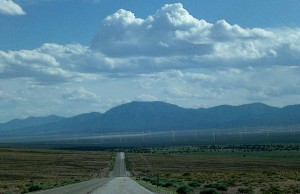

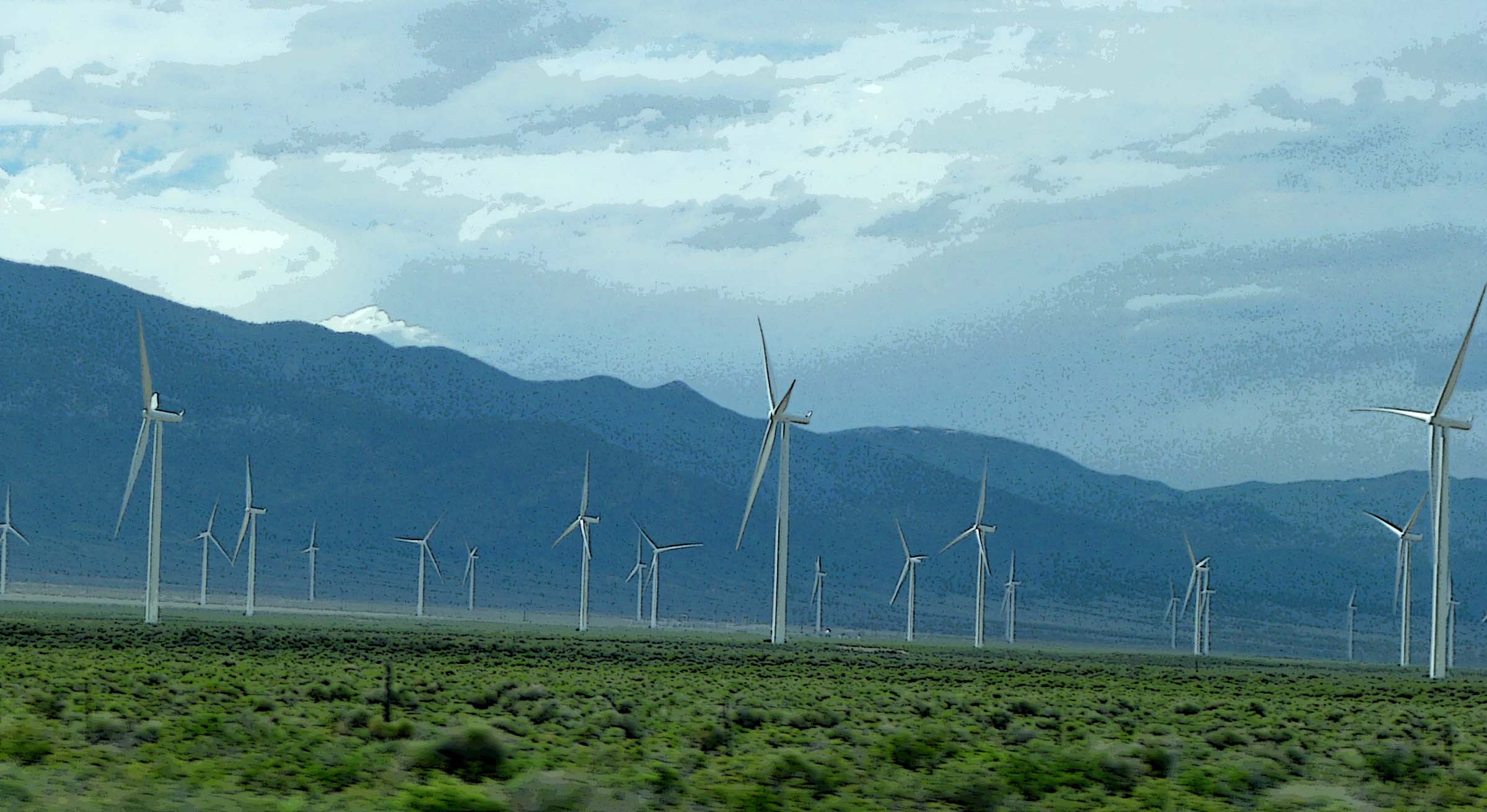


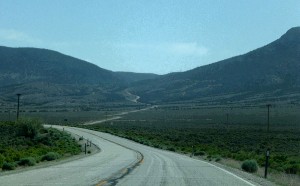

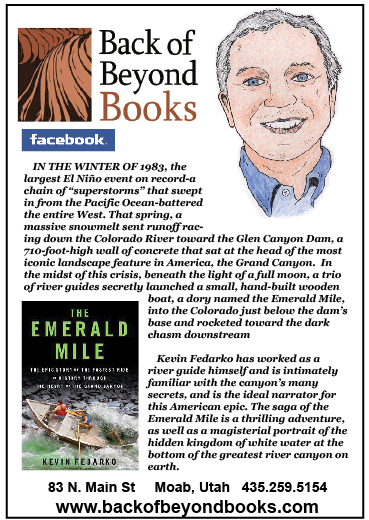
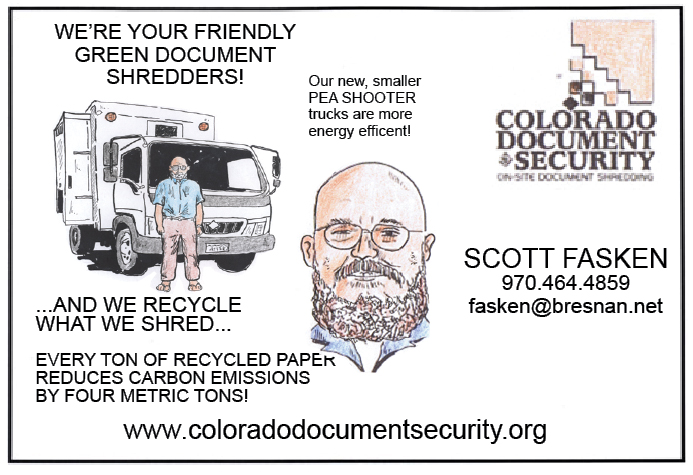
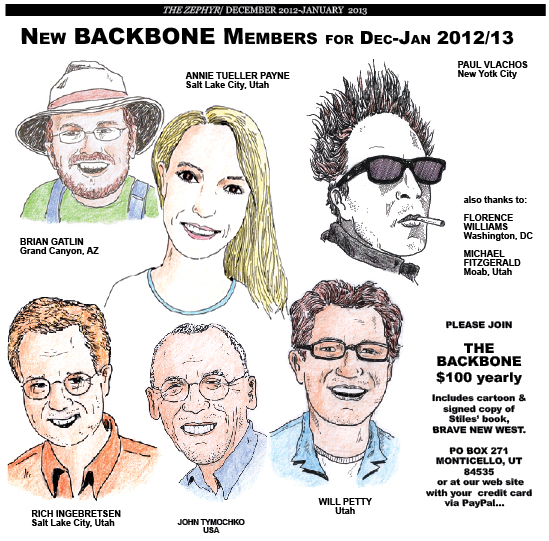



I have been thinking along the same lines for quite some time. The deserts are likely to be a National Sacrifice Zone for renewable energy. Since I love deserts, I find this trend deeply disturbing. The destruction process is already well along in California. What happened with the Ivanpah solar project is an example. I’m sure you’ve noticed that the rhetoric from the White House promoting renewable energy never includes discussion of the fact that we need to reduce per capita energy consumption as part of the switch to renewable energy sources! The “American Way of Life” is a sacred cow.
Sheer desperation. That’s what a wind farm is and the whole world can see it, including the Chinese who loan them to us. Their best customer is a joke. Wouldn’t be surprised if they get tired of us sooner rather than later.
This is a great, but difficult to read article. I do like seeing the perspective of a traveler through Nevada. I have lived in the Mojave Desert for 25 years, the last 12 being in a remote part of Nevada, not too far from Death Valley. Been following the Spring Valley wind farm since before it was built. I was a park ranger at Great Basin National Park in 1990-91. This wind farm is now visible from the Wheeler Peak Trail. Now when you walk on the trail, all you need to do is look north west and the turbines a visible in the day and the flashing red aviation lights visible all night. They built this wind farm about 3 miles from the Rose Guano Cave which is a roosting colony for over 1 million Mexican free-tail bats. Big turbines kill bats by causing pressure that causes their lungs to burst. Pretty odd, but dead bats are found near every North American wind turbine (and everywhere else). Well BLM and Pattern Energy promised they would mitigate this by “monitoring” the bats. But they only monitor 1/3 of all the turbines. Still, they have found about 300 dead bats by the turbines since the project went on-line they are monitoring. So that’s it, ecological genocide for a project where the turbines are reported to not be spinning much.
I will say that Nevadan’s near Pioche, Nevada did help chase away one wind project called Wilson Creek/Table Mountain.
This is absolutely the truth: ” President Obama knows he won’t get people with serious money to help him deal with climate change unless … and (2) he can find a way to keep them (or make them) fat-ass wealthy.” This is the mission statement of the so called Green energy movement. Green = Money when it comes to these “green energy projects” I am appalled at how this alternative energy movement was twisted from something good and true and turned into political largesse. I live near one of the largest wind farms in California, they have installed over 400, 45 story windmills. My local planning person told me at a public meeting kern county gets about 2.5 million per year in taxes, per windmill, and of course the great state of Calif. is seeking to also charge use tax on the cost of the windmills as well. So pretty safe to assume our public officials are seeking to insure their benefit packages are well funded, while long time tax paying residents get stuck with, oil leaking, noise making, eyesores, and have had their property equity robbed. The General plan was changed, special permits to kill endangered wildlife were given, cross country transmission lines built so this rape can occur. The age old Environmental axiom, Reduce, Reuse, Recycle. out the window as all this ugly new construction occurs just so government can separate working folks from their hard earned money to feed their super rich fat cat friends, and with the added slap in the face of ruining our quiet desert lifestyle.
Getting scared to take my annual trip to Nevada, because of all the new ugliness I see each year. The entire west is being eaten up by energy projects, until nothing left.so sad. (don’t forget the attempt to turn the Black Rock desert in S.F.’s garbage dump.
Very good article. I’m glad I got to see Great Basin National Park before they “greened” it up with the Spring Valley Wind blight in 2012. The sense of remoteness from Wheeler Peak is tainted as you look northwest at 66 wind turbines spanning a 3 x 3 mile area near 893 (map: 39.098967, -114.490982). Pattern Energy claims the footprint is only 77 acres, which is the same propaganda used to make ANWR drilling seem benign. They pretend the widespread vertical impact is trivial and only the tower bases and roads create impact!
Just like most wind turbine junkies, Obama was never a true environmentalist. He decided that the landscape doesn’t matter nearly as much as the agenda of carbon footprint reduction, which has overshadowed Man’s growing physical footprint on the land. Do we want a world that’s ostensibly green but increasingly hard to look at and relax in? Look up the term “fossil fuel extenders” to see that most “renewable” energy really isn’t. We are in store for some major economic downsizing when critical fossil fuel peaks arrive. The first warning shot was the 2008 recession, triggered by the earlier 2005 plateau of global crude oil production. Shale and tar sands can’t keep pace with demand much longer. It’s about declining flow-rates.
Given human nature, I don’t see a much standing in the way of further desert blight. Too many people think the desert is just empty space to speed through in their gas hogs, implying that land not jammed with people, machines and noise is useless. But the very lack of those things is what has so much appeal for those with aesthetic values. A song like America’s “Horse With No Name” loses its profundity when you imagine every valley filled with white skyscrapers or lakes of solar mirrors. There may come a time when you can’t drive across America without seeing industrial blight every few miles. Europe is already getting fed up with wind turbines, especially Scotland, which values its wild places more than most.
Based on my travels in the Great Basin, I don’t recall it being windy enough to justify too many turbines, but that’s at the valley level. A worst case scenario is that they’ll fill the valleys with solar mirrors and crown smaller, accessible peaks with wind turbines. They’d better not desecrate the higher peaks, even if it’s technically practical to build roads there. The fact that only one major project exists so far may be a good sign. They’ve had a lot of time to scout out areas.
We can hope that nuclear fusion becomes a reality by some miracle, since that’s the only sustainable power source that would be a real game-changer. Solar photovoltaic is my second choice because it has a small footprint, even if it’s not so efficient. Geothermal plants seem relatively benign but are locked into certain locations.